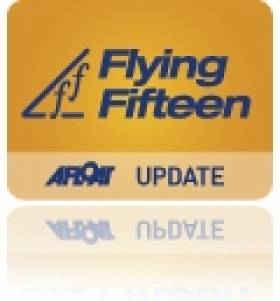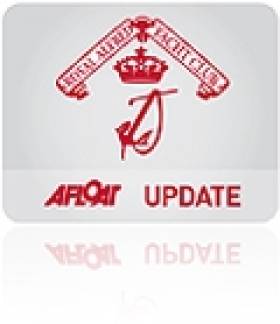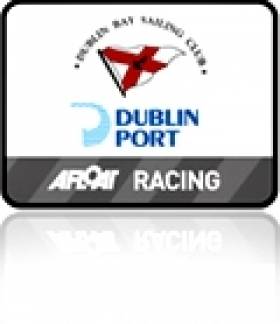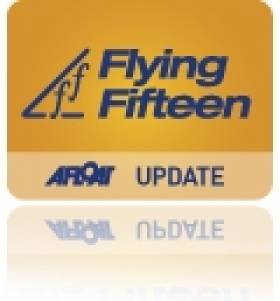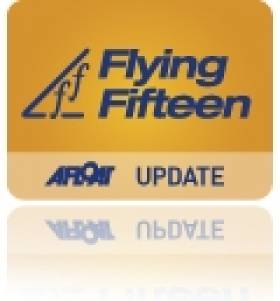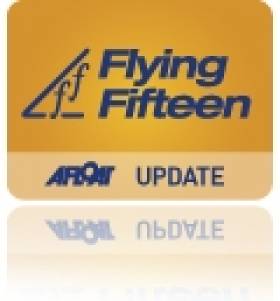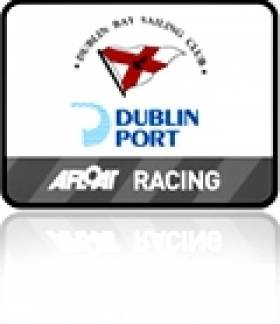Displaying items by tag: Flying fifteen
McKee and Smyth Lead Irish hopes at Flying Fifteen Worlds
Brian McKee and Ian Smyth lead Irish hopes after five races sailed at the Flying Fifteen World championships at Hayling Island Sailing Club this morning. The Strangford Lough pair have had a consistent string of results in a mainly patchy light winds series that has threatened the two week regatta to date.
Counting 52 points McKee lies in tenth place overall, his results tally includes a race win in the opening race in the 120-boat fleet that - controversially - has been divided in to two fleets for this, the 18th World Championships.
Other Irish results include John Lavery and David O'Brien in 23rd, Peter Lawson and Barry Bridges in 40th, 59th Ben Mulligan and Alistair, Doherty, 70th David Mulvin and Ronan Beirne, Tom Murphy and Steven Lloyd in 82nd.
Racing continues until Thursday.
More on yesterday's racing from the organisers here:
Three more races in a good breeze got the Flying 15 Worlds back on schedule Sunday. Mike and Gemma McIntyre headed the list of winners with a 1, 5, 1 score line. Series leader Graham Vials and Chris Turner keep their overall lead, winning their first flight race but suffering a black flag DSQ in the final race. Other race winners were Andy McKee and Richard Jones, Russell Peters and Tim Hall, and Mike Hart and Richard Rigg.
Winners in the Classic/Silver fleet were Bobby Salmond and Robert Till in Classic GBR627 from the Holy Loch SC. Malcolm and Alex Hall, keep the overall lead and first Silver boat. First Classic overall are Gavin Cassidy and Lucy Clough.
Three more races in a good breeze for each of the flights allowed PRO Roger Palmer to get the Flying 15 Worlds back on Schedule Sunday and complete the qualifiers. The westerly breeze stayed around the 15 knots mark, providing the best day of the competition so far.
Championship leaders Graham Vials and Chris Turner keep their overall lead, winning their first yellow flight race but suffering a black flag DSQ in the final race. The day produced some dramatic place changing. The defending champions, Grant Alderson and Dean Mcaullay from Australia, resurrected their challenge with a steady 5, 5, 3, to move from 16th to second place, five points off the leaders.
[Grant Alderson and Dean Mcaullay AUS]
The Aussie pair were surprised at their overall position, Alderson describing it as a steady day, holding their position off the line and maintaining it round the course, with no big gains or losses. The elevation of Alderson and Mcaullay was balanced by their compatriots, Ron Packer and Peter Mudford, who dropped from second to finish the day in 14th.
Greg Wells and Mark Darling finished the day as they started, an 8, 6, 2 score keeping them in third place overall, six points off the lead. It was Mike and Gemma McIntyre who made the most of the day, rocketing from 27th to fourth with two race victories and a fifth. In their first blue flight race they came out the line at the committee boat end to go right. At the first mark, Mike Hart and Richard Rigg led, the McIntyres second and Jeremy Davy and Simon Childs third. McIntyre passed Hart and Rigg on the run and then held off Davy and Childs. On the next beat they went on port to the right corner and were 50 meters ahead on the reach and run and into the finish, Davy and Childs taking second and Hart and Rigg third.
In Race 2 the Irish pair, Peter Lawson and Barry Bridges port tacked the fleet and the McIntyres, who had over stood the windward mark, rounded in 12th. On the run they stayed on the right-hand side took the right-hand mark, tacked onto port and pulled themselves through to a fifth place finish.
Goacher and Evans are Flying 15 UK National Champions
After several hours of waiting and one race start for the gold fleet, which was abandoned before they reached the windward mark. PRO Roger Palmer signalled the end of racing and the British Championship was officially over. An anticlimactic end to a difficult week, which had been plagued with unseasonable summer weather from day 1. The practice race and the first two races were lost due to the storms of the opening weekend. Monday was an exciting days sailing for those who could stand the pace, big seas and strong winds providing conditions that the 15 excels in.
And those conditions were very much to the liking of defending champions, Steve Goacher and Phil Evans, as they blasted to two victories. The conditions brought to the fore a lot of familiar names, revelling in the spray and spume: Russell Peters and Tim Hall, Greg Wells and Mark Darling, Charles Apthorp and Gavin Tappenden and Australian's Grant Alderson and Dean Mcaullay, and Dave Tucker and Matt Summers. But a significant factor in the day's results was the retirement rate in the rough sea conditions and the number of black flag transgressions, something that was to be critical as the week unrolled.
Now, all thoughts turn to the Flying 15 World Championship which begins on Friday. Headed by Goacher and Evans the Britsh fleet has great depth and they are looking to return the World title, held by Australians Grant Alderson and Dean Mcaullay, to the Old Country. The strong Aussie entry plus the 28 extra boats joining the fleet for the Worlds, including additional entries from Belgium, Hong Kong, Ireland and France might just upset that plan . . . weather permitting. -- Gerald New
Flying 15 Championship of the British Isles (Pre Worlds Regatta)
Top five:
1. Steve Goacher / Phil Evans, GBR, 4 points
2. Russell Peters / Tim Hall, GBR, 6
3. Charles Apthorp / Gavin Tappenden, GBR, 7
4. Greg Wells / Mark Darling, GBR, 7
5. Jeremy Davy / Smon Childs, GBR, 8
It's been around for more than 50 years but enthusiasim for sailing's Flying 15 keelboat continues to grow. This weekend will see the start of two weeks of intense competition with the British National and the 18th running of the World Championship titles taking place. Over 100 of the Uffa Fox designed two-man keelboat will take to the waters of the Solent from the Hayling Island SC, with boats of over 40 years old competing with new boats launched for this event.
Six Irish boats are entered with the National Yacht Club represented by three boats. Dun Laoghaire's Alan Green crewing for top British sailor Charles Apthorp are listed as front runners for the worlds title. Northern Ireland's Brian McKeen and Ian Smyth represent Strangford Lough Yacht Club. Irish class president Ben Mulligan is sailing with Jay Bourke. John Lavery and David O'Brien of the National Yacht Club and David Mulvin and Ronan Beirne are also sailing. Full entry list here.
A long time favourite in Australia, New Zealand, South Africa and Hong Kong, the class has seen recent growth in Europe and this year's World Championship includes competitors from Ireland, France, Belgium and Spain. The British Nationals will form the Pre-event for the Worlds and provide a last chance to qualify, which will add an extra edge to the National Championship.
The qualifying events in the UK have seen a variety of winners including Russell Peters and Tim Hall, recent Southern championship winner, Charles Apthorp sailing with Dun Laoghaire's Alan Green. And finding a lot of speed lately at HISC, Mike McIntyre and his daughter Gemma. Multi world and national champions, Steve Goacher and Phil Evans are never far from the front when it comes to the big occasion and topped the UK qualifying.
Names to look for from the large Australian entry include defending World Champions Grant Alderson and Dean Mcaullay, and David Tucker and Matt Summers (7th 2009). From New Zealand Murrey Gilbert and Jon Burgess are in form and the Irish crews could spring an upset on the established order.
With what the Met Office describes as an unseasonably deep low affecting the UK, weather for the early part of the Nationals is expected to be rain showers with winds building to force 6 to 8 for the opening races on Sunday. The strong wind is expected to ease from Monday. The Nationals complete on Wednesday 20 July, there is a lay day on Thursday, then the Worlds start on Friday 22 July through to Thursday 28 July.
Gorman and Doorly Lift Flying Fifteen Title on Home Waters
Dublin Bay racers David Gorman and Chris Doorly have been crowned Flying Fifteen national champions tonight at the National Yacht Club after a seven race series on home waters. The Dubliners hled off a strong challenge from Northern Ireland pairings Brian McKee and Ian Smyth and Roger Chamberlian and Ian Scannell, both from Strangford Lough. The results of the last race this afternoon decided the title. 26 competed. McKee and Smith took second and Chmberlain/Scannell were third.
With no wind and racing on Friday, the Championship got under way in Dublin Bay on Saturday. In testing conditions race officer Con Murphy and his team provided four races with a further three on Sunday ensuring a full schedule.
Some of the fleet will head for the worlds in Hayling Island, Hampshire in July with the local travelling circuit continuing in Dunmore East in August and Cushendall in September.
RS Elites Add Colour to Baily Bowl Weekend
Low pressure systems played havoc with the Royal Alfred YC Baily Bowl on Dublin Bay this weekend with visitors from Belfast Lough adding much needed colour writes our Dublin Bay Correspondent. The one design fixture struggled to attract big numbers in any of the four fleets sailing and the local Flying fifteen class opted out altogether.
The one design weekend is part of the 2011 Royal Alfred Season.
Race officers Brian Reddy and Barry MacNeany succeeded in completing three races on Saturday on both race courses but 50 knot gusts on a white Dublin Bay put paid to Sunday racing entirely.
Simon Brien from Cultra sailing Kin won the six boat Dragon fleet with two firsts and a second from Richard Goodbody and the Johnson Brothers Diva. Next week the class East coast championships will be held on the bay.
Peter Wallace's Toy for the Boys took the Squib class from local Frank Whelan in Lola.
Vincent Delany, a favourite for the Squib event, didn't show his usual form in third returning twice at starts and struggling up through the fleet.
Requests for redress from the race committee after recall signal misfire were denied according to the RAYC.
Peter and Marie Dee in Kookaburra after winning race two, lost third place overall to Delany after retiring from the final race.
In the six boat RS Elite fleet which decamped from the shores of Belfast Lough, Tiffany Brien crewed by Jay Bourke tied with John Patterson in Momentary Lapse on 7 points but lost on tie break. The Laser radial sailor still beat her uncle Mark in Full Marks!
Trevor Darcy and Simon Hutchinson from Carrrickfergus in Bullet won the SB3 fleet by a point from Colin Galavan's Defiant after the fleet retired from the final race as the wind touched force six.
Spot the mark was the order of the day on Dublin Bay for this afternoon's Dublin Bay Sailing Club (DBSC) race as boats, ships and racing marks appeared - and disappeared - in a sea mist that persisted all afternoon. The south easterly breeze that had prevailed this week means Forty foot mark, located just off Sandycove point, has got more than its fair share of use. Last Thursday's courses came in to play again this afternoon in Scotsmans bay.
David Williams of the Royal St. George Yacht Club sailing Phantom produced the same form as Thursday night to win from Michael Doorly in Aphrodite in a seven boat Dragon fleet. In the Flying fifteen's Frank Burgess of the National Yacht Club won both races. The SB3 results have not been recorded and nor have Cruisers Zero. John Maybury's Cruiser one entry, the J109 Joker, was a winner on IRC and Chris Moore's J109 Powder Monkey was the ECHO handicap winner. The rest of the DBSC results from this afternoon's race are below:
As the DBSC fleet sailed back to their moorings more boats appeared out of the mist around 4.30pm. It was the leading pack of the ISORA fleet returning from their second race to Rockabill and back. And bringing them home was Bay regular Derek Martin's Lively Lady. Click for our ISORA story here.
BENETEAU 31.7 - 1. Flying Machine (Conor O'Gallagher), 2. Prospect (Chris Johnston), 3. Bluefin Two (M & B Bryson)
BENETEAU 31.7 Echo- 1. Prospect (Chris Johnston), 2. Fiddly Bits (Kevin Byrne et al), 3. Flying Machine (Conor O'Gallagher)
CRUISERS 1 - 1. Joker 11 (John Maybury), 2. Something Else (J.Hall et al), 3. Aztec 3 (Peter Beamish)
CRUISERS 1 Echo - 1. Powder Monkey (C.Moore/M.Byrne), 2. Joker 11 (John Maybury), 3. Aztec 3 (Peter Beamish)
CRUISERS 2 Echo - 1. Dick Dastardly (B.Cusack et al), 2. Jawesome 11 (V.Kennedy/M.Dyke), 3. Smile (O'Connell/Healy/O'Sullivan)
CRUISERS 2 - 1. Jawesome 11 (V.Kennedy/M.Dyke), 2. Bendemeer (Lindsay Casey Power), 3. Smile (O'Connell/Healy/O'Sullivan)
CRUISERS 3 Echo - 1. Gung Ho (G & S O'Shea), 2. Hyflyer (John Barnard), 3. Cacciatore (Anne O'Callaghan et al)
CRUISERS 3 - 1. Gung Ho (G & S O'Shea), 2. Hyflyer (John Barnard), 3. Papytoo (M.Walsh/F.Guilfoyle)
CRUISERS 4 - 1. Maranda (Myles Kelly), 2. Ghrazel (Charles Pearson)
DRAGON - 1. Phantom (D.Williams/P.Bowring), 2. Aphrodite (Michael Doorly et al), 3. Susele (Michael Halpenny)
FLYING FIFTEEN - 1. Snow White (Frank Burgess), 2. The Big Bow Wow (N.Meagher/N.Matthews), 3. Fflogger (Alan Dooley)
FLYING FIFTEEN Race 2- 1. Snow White (Frank Burgess), 2. Hi Fibre (Michael McCambridge), 3. The Gruffalo (Keith Poole)
GLEN - 1. Glenluce (D & R O'Connor), 2. Glenshesk (L.Faulkner et al), 3. Glendun (B.Denham et al)
IDRA 14 FOOT - 1. Dunmoanin (Frank Hamilton), 2. Doody (J.Fitzgerald/J.Byrne), 3. Squalls (Stephen Harrison)
IDRA 14 FOOT Race 2- 1. Dunmoanin (Frank Hamilton), 2. Squalls (Stephen Harrison), 3. Doody (J.Fitzgerald/J.Byrne)
MERMAID - 1. Jill (P.Smith/P.Mangan), 2. Lively Lady (G O'Neill & M Hanney), 3. Kim (D Cassidy)
MERMAID Race 2- 1. Lively Lady (G O'Neill & M Hanney), 2. Jill (P.Smith/P.Mangan), 3. Kim (D Cassidy)
PY CLASS - 1. E Ryan (RS400), 2. F.Heath (Laser 1), 3. Desmond McCarthy (Laser 1)
PY CLASS Race 2- 1. F.Heath (Laser 1), 2. Desmond McCarthy (Laser 1), 3. E Ryan (RS400)
RUFFIAN 23 - 1. Ruffles (Michael Cutliffe), 2. Ripples (Frank Bradley), 3. Diane ll (Bruce Carswell)
SHIPMAN - 1. Gusto (C Heath), 2. Jo Slim (J.Clarke et al), 3. Whiterock (Henry Robinson)
SIGMA 33 - 1. White Mischief (Timothy Goodbody), 2. Gwili Two (D.Clarke/P.Maguire), 3. Popje (Ted McCourt)
SQUIB - 1. Femme Fatale (Joe O'Byrne), 2. Kookaburra (P & M Dee), 3. Nimble (Brian O'Hare)
SQUIB Race 2- 1. Femme Fatale (Joe O'Byrne), 2. Nimble (Brian O'Hare), 3. Kookaburra (P & M Dee)
WHITE SAIL CRUISERS Echo- 1. Sea Safari (Jacquelin Smith), 2. Calypso (Howard Knott), 3. Nirvana (Bernard Neeson)
WHITE SAIL CRUISERS - 1. Calypso (Howard Knott), 2. Act Two (Michael O'Leary et al), 3. Arwen (Philip O'Dwyer)
National YC to Stage 2011 Flying 15 National Championships
Martin and Murray Continue Flying Form
Strangford Lough sailors maintained their grip at the top of the Irish Flying Fifteen fleet in the last event of the season. National champions Darren Martin and Simon Murray were the winners of the five race light air series on Carlingford Lough at the weekend. Second overall in the 34-boat fleet was Gerry Reilly and P. Quail and third Roger Chamberian and J. Scammell. Full results attached for download.
Big FF Turnout in Carlingford
The fleet drawn from Strangford Lough, Carrickfergus, Dunmore East, Dun Laoghaire as well as the host port almost was double the size of July's National championship fleet at Carrickfergus.
But for all the new faces there were familiar names at the top. National Champions Darren Martin and Simon Murray have built a commanding lead after scoring 2,1,1 in northetly winds shifting up to 30 degrees. There is a fight for second overall but Dun Laoghaire's John Lavery and David O'Brien are detainly in with a chance counting 1,10 and 2. Brian McKee and Steven Martin are also in the frame.
Phantom a Worthy Winner in Blustery DBSC Bay Race
Exhilarating north westerly winds brought the one design fleets sailing planing downwind into forty foot mark tonight in DBSC. There was some spectacular reaching in the Squib and Flying Fifteen classes but none more so than in the Dragons where 20 knots gusts meant the entire fleet had to douse kites before reaching the leeward mark off Sandycove point. David Williams in Phantom emerging as tonight's worthy winner in the three man keelboat. Full results below.
DUBLIN PORT Dublin Bay Sailing Club Results for 12 AUGUST 2010
BENETEAU 31.7 ˆ ECHO 1. Kernach (Eoin O'Driscoll), 2. Violet Flame (B.Murphy/L.Osbourne), 3. Bluefin Two (M & B Bryson)
BENETEAU 31.7 - 1. Prospect (Chris Johnston), 2. Bluefin Two (M & B Bryson), 3. Legally Blonde (C.Drohan/P.Egan)
CRUISERS 0 - ECHO 1. Tiamat (Tim Costello), 2. Lively Lady (Derek Martin), 3. Tsunami (Vincent Farrell)
CRUISERS 0 - 1. Tiamat (Tim Costello), 2. Lively Lady (Derek Martin), 3. Tsunami (Vincent Farrell)
CRUISERS 1 - ECHO 1. Indecision (Declan Hayes et al), 2. Something Else (J.Hall et al), 3. Team Windmill (Andrew Sarratt)
CRUISERS 1 - 1. Something Else (J.Hall et al), 2. Gringo (Tony Fox), 3. Joker 11 (John Maybury)
CRUISERS 2 - ECHO 1. Bendemeer (Gerald Kinsella), 2. Dick Dastardly (B.Cusack et al), 3. Cor Baby (Keith Kiernan et al)
CRUISERS 2 - 1. Dick Dastardly (B.Cusack et al)
CRUISERS 3 - 1. Hard on Port (Flor O'Driscoll), 2. Gung Ho (G & S O'Shea), 3. Rattler 2 (Austin Whelan)
CRUISERS 3 - ECHO 1. Lady Rowena (David Bolger), 2. Gung Ho (G & S O'Shea), 3. Hard on Port (Flor O'Driscoll)
CRUISERS 4 - 1. Ghrazel (Charles Pearson), 2. Aslana (J.Martin/B.Mulkeen), 3. Maranda (Myles Kelly)
DRAGON - 1. Phantom (D.Williams/P.Bowring), 2. Zu (P.Dee et al), 3. Zinzan (Daniel O'Connor et al)
FLYING FIFTEEN - 1. Deranged (C.Doorly), 2. The Gruffalo (Keith Poole), 3. Snow White (Frank Burgess)
GLEN - 1. Glenroan (Terence Moran), 2. Glencorel (B.Waldock/K.Malcolm), 3. Glenmarissa (F.Elmes/W.Higgins)
RUFFIAN 23 - 1. Diane ll (Bruce Carswell), 2. Ruffles (Michael Cutliffe), 3. Ruff N Ready (Ann Kirwan et al)
SB3s - 1. Sin Bin (Barry O'Neill), 2. Design Security (Colin Galavan), 3. Alert Packaging (Justin Burke)
SHIPMAN - 1. Curraglas (John Masterson), 2. Kelema (N.Blake/Z.Grace), 3. Therapi (Alan McCarthy et al)
SIGMA 33 - 1. White Mischief (Timothy Goodbody), 2. Rupert (R.Lovegrove/P.Varian), 3. Popje (Ted McCourt)
SQUIB - 1. Why Not (Derek & Jean Jago), 2. Kookaburra (P & M Dee), 3. Tais (Michael O'Connell)
WHITE SAIL CRUISERS - 1. Act Two (Michael O'Leary et al), 2. Albireo (Michael Murphy), 3. Calypso (Howard Knott)
WHITE SAIL CRUISERS - ECHO 1. Act Two (Michael O'Leary et al), 2. Calypso (Howard Knott), 3. Hypertension (William Rickard)





























